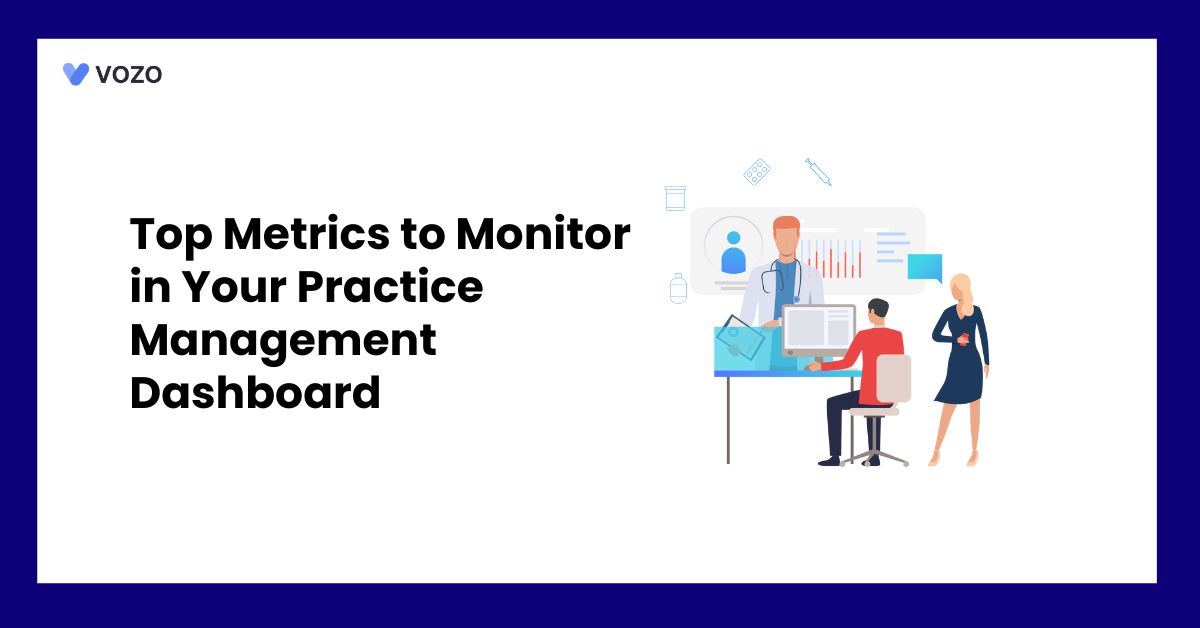Top Metrics to Monitor in Your Practice Management Dashboard
Running a successful practice demands data-driven decision-making in addition to patient care. A well-structured practice management dashboard acts as a real-time control center, providing a full overview of your clinic’s performance. However, with so many data points accessible, choosing which KPIs to focus on might be the difference between development and stagnation.
Monitoring the correct KPIs allows you to make educated decisions, simplify processes, and enhance care quality. In this blog, we’ll look at the key indicators that every healthcare practice should monitor.
Top Metrics to Monitor in Your Practice Dashboard
1. Financial Performance Metrics
Financial health is important for every practice. Monitoring these data ensures that you get paid on time, get the most out of your reimbursement, and remain profitable.
Accounts Receivable Days
The average number of days it takes to receive payment for services delivered is AR.
A high AR days value suggests cash flow issues and inefficiencies in invoicing and collection. Well-managed practices typically have a target range of 30-45 days.
Collection Ratio
Total payments collected divided by total costs billed in a particular time. This indicates how well your billing staff converts billable services into actual revenue. Practices must aim for 95% or above.
Denial Rate & Reasons
The percentage of claims declined by payers and the underlying factors, such as coding problems, missing authorizations, is called the denial rate.
Frequent denials reduce revenue and highlight process or training shortcomings. Identify the reasons for denial and apply targeted solutions such as programmer refresher training.
Net Revenue Per Visit
The practice’s average revenue retained per patient interaction after adjustments and write-offs. Tracks how various service lines impact your bottom line. Use it to make resource allocation decisions.
2. Operational Efficiency Metrics
Smooth operations reduce wait times, improve throughput, and promote patient satisfaction. Focus on these operational efficiency metrics to improve processes.
Appointment Utilization Rate
The calculation is (total appointment slots filled ÷ total appointment slots available) x 100%.
Underutilized schedules result in lost income and exhausted staff when overbooked. Use capacity planning and wait-listing options to fill last-minute openings.
No-show and Cancellation Rate
The percentage of booked appointments where the patient does not show up or cancels too late. High no-show rates might affect physicians’ time and complicate scheduling.
Automated reminders such as texts, emails, and cancellation procedures can reduce this to below 5-7%.
Average Check-In/Check-Out Time
Time passed between a patient’s arrival at reception and the end of their visit. Long visit cycle times suggest bottlenecks, which might be in registration, rooms, or paperwork.
Break down into sub-intervals such as registration, waiting area, and exam room to identify concerns.
Staff Productivity and Utilization
Staff productivity is calculated by “visits per provider per day” rather than “tasks completed per staff member.” It illuminates workloads and reveals training requirements or possibilities for task shifting.
Optimize staffing by aligning with peak patient volumes and cross-training for flexibility.
Related: 8 Top Practice Management Software Features In 2025
3. Clinical Quality and Outcome Metrics
Preventive Care Compliance
The percentage of eligible patients with up-to-date screenings, mammograms, colonoscopies, and vaccines. Value-based care efforts can result in incentive payments from various payers. Use registry tools and automated outreach to close care gaps.
Metrics for Chronic Disease Management
Diabetes control rates (percentage of diabetics with A1C <7%). Showcases clinical efficacy and promotes public health efforts. To improve workflow, include decision-support cues in the calendar and collaborate with care teams like nurses, health coaches.
Patient Safety Events
This refers to incidents such as prescription mistakes or safety-related complaints. Even little negative incidents can have significant reputational and financial consequences. Analyze both near-misses and actual incidents for fundamental causes.
4. Patient Experience and Engagement Metrics
Patient Satisfaction Scores
Survey-based evaluations on communication, wait times, and overall experience. Directly affects referrals and online reputation. Improve by reviewing comments regularly, sharing scorecards with employees, and celebrating successes.
Online Reputation and Review Trends
On sites such as Google, Healthgrades, and Vitals, users may provide stars and qualitative feedback. These are important factors for prospective patients to consider when selecting doctors. Respond quickly to evaluations, both favorable and negative, and identify any improvements made.
Patient Portal Adoption and Usage
The percentage of patients who have enrolled and are actively utilizing online tools for appointment scheduling, bill payment, and chart access.
Digital engagement is associated with increased satisfaction and operational efficiency. Boost adoption by integrating portal signup into check-in routines and providing brief “how-to” tutorials.
Related: A Complete Guide To Healthcare Practice Management In 2025
5. ROI and Cost-Benefit Metrics
Dashboard Adoption Rate
The percentage of users who actively utilize your dashboard is crucial for achieving financial and operational advantages.
Cost Savings
Estimate reductions in staff overtime, printing expenses, and phone call volume following workflow automation. Tie these savings to particular dashboard notifications or automations.
Revenue Growth and Metrics
After introducing your dashboard, you may notice an increase in collections due to faster rejection resolution or increased appointment usage. Using “before vs. after” comparisons can be effective.
Payback Period
Divide the overall cost of dashboard installation by the yearly net benefit, as revenues earned plus costs saved. This helps in how fast stakeholders can repay their investment.
6. Predictive Analytics and AI-Driven Insights
No-show Risk Score
Using previous patient behavior and demographics, assign a “risk score” to each forthcoming visit and prioritize outreach appropriately.
Predictive Revenue Forecast
Forecast monthly and quarterly revenues using seasonal trends, payer mix changes, and provider schedules to aid in staffing and cash reserve planning.
Optimal Staffing Models
Use machine learning to anticipate patient volume by hour or day, and then recommend staffing rosters that balance quality of care with labor costs.
Care Gap Closure Probability
Determine which patients are least likely to respond to preventative outreach, and then alter your engagement techniques accordingly, like a tailored message vs phone calls.
Related: Practice Management vs EHR-Bundled Solutions: What’s Best for Your Organization?
Vozo Practice Management Software
At Vozo, we understand that running a dental clinic presents its own set of issues, from appointment scheduling to revenue tracking and everything in between.
Our Practice Management System is designed to streamline your workflow, improve revenue cycles, and interface with EHR systems all in one place.
With Vozo PM software, you can:
- Automate billing and reduce manual paperwork
- Schedule patient visits effortlessly with an intuitive system
- Integrate seamlessly with EHR/EMR platforms
- Speed up payment processing and improve cash flow
- Receive faster reimbursements with accurate claim submissions
- Enhance claims processing for fewer denials and quicker approvals
Whether you’re looking to build a new practice management system or customize your existing solution, Vozo has you covered.
About the author

With more than 4 years of experience in the dynamic healthcare technology landscape, Sid specializes in crafting compelling content on topics including EHR/EMR, patient portals, healthcare automation, remote patient monitoring, and health information exchange. His expertise lies in translating cutting-edge innovations and intricate topics into engaging narratives that resonate with diverse audiences.













